4 Legendary Ski Bars
What makes a ski bar a legend? It’s the abundance of good times, year after year, and the people who bring those good times into your life.
CHEZ HENRI
At Chez Henri, a Parisian-style bistro at the base of Lincoln Peak, Henri Borel has been bringing good times to Sugarbush for 54 years. And he’s still going strong. For years, each spring he presided over the Chez Henri Cup: a race followed by a fondue party. Last year, it was rekindled as a celebration of Henri Borel’s 90th birthday. This February 11, he will celebrate his 91st. And yes, he still races.
A wiry Frenchman with boundless energy, Henri, as everyone calls him, captured the 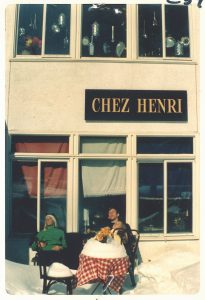 essence of good times during the high-flying “Mascara Mountain” years at Sugarbush during the early ’60s. That’s when Olympic skier Jean Claude Killy and Vincent Sardi (owner of New York’s Sardi’s on Broadway) were regulars at Chez Henri. And among Henri’s frequent guests were actor Paul Newman, the Kennedy clan, the Heinz family, Yoko Ono, Olympic skier Buddy Werner, socialite Nan Kempner and New York City jetsetters and original Club Ten founders Skitch Henderson, and Igor and Oleg Cassini (the designer and close friend of Jackie Onassis).
essence of good times during the high-flying “Mascara Mountain” years at Sugarbush during the early ’60s. That’s when Olympic skier Jean Claude Killy and Vincent Sardi (owner of New York’s Sardi’s on Broadway) were regulars at Chez Henri. And among Henri’s frequent guests were actor Paul Newman, the Kennedy clan, the Heinz family, Yoko Ono, Olympic skier Buddy Werner, socialite Nan Kempner and New York City jetsetters and original Club Ten founders Skitch Henderson, and Igor and Oleg Cassini (the designer and close friend of Jackie Onassis).
Sugarbush attracted a who’s who of American society for those few years, with Olympic gold medalist Stein Ericksen running the ski school at the time and holding court—almost daily—at Henri’s bistro.
“He was my best customer those first years,” Henri remembers, recalling Eriksen’s legendary good looks and his international clientele. “He drew a crowd all around him. It was good for everyone that he was here—except maybe for the husbands,” he says with a sly smile.
In those years the Sugarbush trail maps featured a run called “Out to Lunch,” that swung off lower Pushover at the base of Lincoln Peak, right to the covered bridge. You crossed the covered footbridge, ducked left and down a few stairs to a lower entrance that is Chez Henri.
There, a courtyard faces Lincoln Peak with ski runs Spring Fling, the Mall and Stein’s Run in full view. Outside, a small circular table with two metal chairs sits surrounded by snow, a red-and-white checkered tablecloth on top, capped with a bouquet of flowers. On a sunny day, it’s a coveted spot for lunch. Henri and his partner Bernard Perillat, who joined him in 1970, would sometimes set up an oyster bar outside for guests, bring more tables, and serve lobster and escargot.
In a documentary made for Henri’s 90th birthday by local filmmaker Charlie Brown, Warren architect Dave Sellers recalled one winter evening, just before Christmas, when he and his date showed up in a snowstorm. Henri greeted them, brushed the snow off that outside table, lit candles and served them wine and his famous warm bread — all while huge snowy flakes fell on top of them. That night they had their full dinner outside. “It was remarkable,” Sellers said. “What a guy! That’s just pretty cool.”
Sellers would become a regular at the bistro and a good friend. He later started a Christmas tradition of showing up with horns and singers to serenade Henri’s guests with carols, with Henri going table to table to get his customers to sing along, pouring champagne freely to all. The caroling would end with a rendition of “Silent Night,” as Henri would dim the lights and everyone would join in. “It was magical,” Sellers recalled, noting they did the caroling for 15 consecutive years.
Henri Borel came to Vermont in 1960, in his early 30s, with Olivier Coquelin—a fellow Frenchman who had introduced Henri to skiing in the Alps—to help at a bistro called Club Ten. Coquelin would go on to New York City to start the famous nightclub, Le Club. Soon, Coquelin convinced Henri to take his place at Club Ten in Sugarbush. He did, along with his wife Rosie, who was then pregnant with their son (later to be named Francois), and six-month old daughter, Francoise. A couple of years later, Borel was convinced by a few of the early investors in Sugarbush to open a restaurant in the newly constructed Sugarbush Village. And that became Chez Henri.
But even while he was establishing Chez Henri, he would leave each summer and fall to help establish large dance clubs in Chicago, Santa Monica and New York under the Cheetah club name and others. He often tells stories about when the Chicago club was bombed during the Democratic National Convention in 1968 or when Jim Morrison of The Doors was performing and made a racial slur. Henri and others had to scramble to prevent a skirmish between Morrison and Black Panthers in the crowd. Or another time when rock-n-roll legend James Brown gave Henri a big smooch. It was all part of the job, and part of what makes Henri the ultimate host—he has stories to regale his friends and customers hour after hour, day after day, year after year.
Those stories, and his obsession with French bread—crisp on the outside so you can hear it crunch when you squeeze it, served warm right out of the oven—are part of the legendary experience at Chez Henri.
And there are the traditions: “We have a famous climbing pole, but the rule is you can only use your arms,” Henri says. The pole, an architectural mistake in the middle of the bar, is covered with a slick paint, and when the scene gets rowdy, the challenge awaits newcomers.
It’s harder than it looks, but it’s been climbed by such notables as: Jean Claude Killy, Stein Ericksen, Sigi Grottendropher, the Cochrans and the Mahre brothers to name a few.
Looking around, Chez Henri looks much as it did 50 years ago. It’s a look and feel that is captured in a time bubble, one former employee says, a time warp that has preserved a special feeling.
Henri and Rosie built the fireplace, found used antique tables for booths, snatched the beautiful white marble bar and stools from a soda fountain in Barre that was going out of business, and bought antique mirrors at auction. Henri hand-chiseled the distinctive archways in the dining room. The back room, famous for its disco dancing in the 1970s and ’80s, still hosts lively parties on occasion.
“I haven’t changed a thing— it’s comfortable, cozy, we have good food, fresh warm bread and good wine—and we’ve been successful because of it,” Henri said recently, while getting ready to serve lunch. “This is our place, it is our memory and that is a very important thing—to keep a place that is in the hearts of your customers.”
And he still loves his work. “People ask me how I stay so active and come to work every day and ski every day. It’s because I enjoy life. If you are unhappy, it’s yourself. Life should be something happy. I love skiing and I’m still living like a ski bum.” —Angelo Lynn
THE MATTERHORN
On a night when cars are parked up and down the Mountain Road and there’s a line at the door of The Matterhorn, Charlie Shaffer has an air of perpetual calm. It may be getting rowdy with a gang doing shots going at one end the bar. The dance floor may be a mosh pit. There may be a skinny-dipping challenge in the river just off the back deck. Shaffer takes it all in with an impish, bemused smile. He greets the regulars with a pat on the arm, and a “good to see you, did you ski today,” runs a hand through his tousled hair and steps back into the kitchen to check on things.
Meanwhile, Louise Shaffer deftly rolls sushi in the sushi/martini bar on the lower level, facing big windows and the river. As Charlie says, “the fish comes off the same boat that serves restaurants in Boston. It gets there at 11 and it is here by 5 pm.”
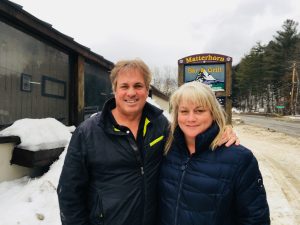 The Matterhorn, a perennial favorite in national “best ski bars in the U.S.” lists, is a near-mandatory watering hole for any skier headed down the Mountain Road from Mt. Mansfield. It’s has been an institution since the 1950s, hosting the Monkees, members of The Grateful Dead and NFL star Doug Flutie and the Flutie Brothers band (whom Charlie sometimes sings with). After being a regular customer, Charlie, a Boston skier who had a weekend house share in Stowe, bought the place in 1996. Soon after, he lost his job as a trader and moved up full time. “It used to be a little more wild here,” he says. “But then again, so were we.”
The Matterhorn, a perennial favorite in national “best ski bars in the U.S.” lists, is a near-mandatory watering hole for any skier headed down the Mountain Road from Mt. Mansfield. It’s has been an institution since the 1950s, hosting the Monkees, members of The Grateful Dead and NFL star Doug Flutie and the Flutie Brothers band (whom Charlie sometimes sings with). After being a regular customer, Charlie, a Boston skier who had a weekend house share in Stowe, bought the place in 1996. Soon after, he lost his job as a trader and moved up full time. “It used to be a little more wild here,” he says. “But then again, so were we.”
Locals Jake and Donna Carpenter, and Burton’s posse of pro riders, are regulars. One night this past January, Ethan Hawke stopped in. Harvey Keitel threw his son’s birthday party here —and sent a video to the kid’s godfather, Robert DeNiro.
The Matterhorn has also been the scene of a (predictable) cat fight on Season Seven of the “Real Housewives of New Jersey” (aired in 2016). In describing the episode, E! Online called the ‘Horn, “A restaurant in the midst of what seems to be an identity crisis (seriously, it looked like a barn and inexplicably served buffalo wings and sushi).”
What they missed is the knack that Charlie, who used to work on the floor of the Boston Stock Exchange, and Louise have for making just about everyone feel at home—be it a fur-clad New Yorker sipping a martini or a 20-year-old liftie downing a Heady Topper.
Over the bar hang mugs belonging to regulars. “We save the mugs for people who work around here and really give back to the community —patrollers ski instructors and such,” Charlie says. They come and bring their 60-year-old private lesson clients. They bring their friends and kids with them. And then they leave (or not) and the music cranks up and a new crowd shuffles in.
“A lot of the people you see here have been coming here since they were in their 20s,” 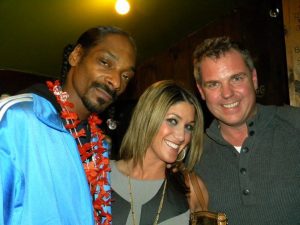 Shaffer says. “I can’t tell you how many met their wives or husbands here.” He looks around and smiles. “Toni and Eileen Bowen, a couple in their late 70s who drive up from Montauk, Long Island, are long-time customers who have become some of our best friends and they bring their kids and grandkids,” Charlie says. “The people I have met in this community and the friends we have made here are just incredible.”
Shaffer says. “I can’t tell you how many met their wives or husbands here.” He looks around and smiles. “Toni and Eileen Bowen, a couple in their late 70s who drive up from Montauk, Long Island, are long-time customers who have become some of our best friends and they bring their kids and grandkids,” Charlie says. “The people I have met in this community and the friends we have made here are just incredible.”
At the back of the bar, beyond two pool tables, kids in ski gear are slamming quarters into a pinball machine. A crew that just skied down the backwoods Bruce Trail (which spills out a hundred feet up the road) has hoofed it in to grab a beer.
The après crowd segues seamlessly into the family dinner crowd, then into a late-night singles scene as the bands shift from one beat to the next. Charlie drums his fingers on the bar to the beat and smiles. No matter how crazy it gets, he always seems to be having a good time. “Perhaps the best thing about owning The Matterhorn is you get to see your friends at work all the time,” he says. “There are some nights when I’m getting ready to go home and in walk some friends, and then I know I’m gonna stay and have a beer with them.” —Lisa Lynn
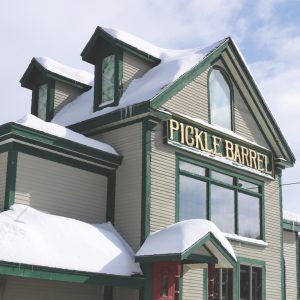 THE PICKLE BARREL
THE PICKLE BARREL
The first time Chris Karr set foot in The Pickle Barrel he was 18. “I came up to take a year off after high school and be a ski bum,” he remembers. He got a job at Killington and began working at The Wobbly Barn, the other big nightspot, also owned by Jack Giguere. Giguere took Karr under his wing and soon he was a manager. “He was really my mentor,” Karr said, and his dying wish was that I should take over the Pickle Barrel.” Karr scraped up enough money and in 1999 became the owner of “The House That Rocks Killington,” as he branded it, and then the parties really started.
“When I was in high school, I started booking bands for our school dances,” Karr says. One of the people he worked with moved on to become Snoop Dogg’s agent. “I called him up one day and asked if Snoop Dogg would ever consider coming to Vermont,” Karr remembers. It was 2011. By the end of the conversation, Karr had booked Snoop Dogg for two sold-out shows.
Karr has also brought acts such as Warren Zevon, the Wailers and others to Killington. “One of the fun things is bringing a band like Yukon Kornelius in. No one knew who they were until they started playing. The crowd went nuts when they realized it was Stefan Lesard from the Dave Mathews band, Ed Robertson of Barenaked Ladies and Adam Gardner and Ryan Miller of Guster.”
Though the big band nights sell out during the winter, for Karr, it’s the local party nights that are just as much fun. “I don’t think I’d ever want to own a place that wasn’t in a ski town like Killington,” he says. “Locals here love to ski hard and party hard and the most fun nights are ones like the annual Miniskirt Party we do as a send-off each April (guys and girls wear miniskirts) or the Pimp and Ho Ho Ho party at Christmas.”
Karr is married now with a four-year-old and an 11-month old at home. He’s also the owner of two other Killington hot spots, Jax and The Foundry but, as he says, “I’m usually the last one home and first one up in the morning.” And he never misses a night out at the Pickle Barrel. — L.L
RED FOX INN
On the morning before the Red Fox Inn opens for the season, Tom Logan sits beside his wife, Cindy—or Ma-Bean, to the locals. To his left looms a giant stone fireplace; to his right, a worn wooden bar with bottles of whiskey and Guiness on tap. Jameson, one of the couples’ three young grandsons, plays with a toy truck on the floor. “He’s got big shoes to fill with a name like that,” says Ma-Bean.
‘The Fox’ is in the heart of southern Vermont’s ski country, within 10 miles of Stratton Mountain Resort, Bromley and Magic Mountain. A tavern, restaurant and inn, it’s been a local favorite since it opened in 1960. The Logans have only upped its popularity.
The Logans grew up in Boston and moved to Vermont in 1975, and after going to the Red Fox as customers, then working there as bartenders and waitstaff, the couple bought the pub in 1984. “We danced seven nights a week here before we owned it,” Ma-Bean says.
When they’re not hosting at the Inn you still find the Logans out on the slopes. Tom’s a skier and Ma Bean teaches snowboarding at Stratton, and occasionally competes in snowboard events in the 50-plus age group.
Unless it’s St. Patrick’s Day. That’s the day Logans host Bondville’s St. Paddy’s Day parade—the oldest and largest in the state of Vermont. After, parade-goers flood the inn, and the Logans get to work serving traditional corned beef and cabbage, Irish soda bread, Guinness, and of course, as Ma-Bean says: “A lot of shots of Jameson.”
On any given night, the regular crowd is split evenly between out-of-staters and locals—including snowboarding superstars Lindsey Jacobellis, Danny Davis and Ross Powers. “It’s nothing to see those guys here,” Tom says. He and Ma-Bean have even spotted William Shatner (Star Trek’s Captain Kirk) at the bar. And Jackie Kennedy used to be a regular, back when she brought her kids to ski at Stratton in the late ‘60s. The crowd only grows on holidays like Halloween and New Year’s Eve, when the inn hosts blow-out parties.
Skier and riders come for the food; upstairs, the restaurant features a menu hearty fare like root vegetable risotto and pan-roasted elk chops. Downstairs, the tavern offers specials like Irish night, with half-priced fish ‘n chips and Guinness. Ma-Bean’s pies are famous—out of hundreds of submissions, her apple pies were chosen to serve to President Obama at the 2009 Inaugural Ball.
And they come for the music. Considered one of the best music venues in southern Vermont, the Red Fox stage has hosted the Neville Brothers, Deep Purple, NRBQ, Seth Yacavone, Sonny Landreth, as well as a traditional Irish band that plays weekly.
At the Red Fox, there’s a little St. Paddy’s day year-round. — Emma Cotton

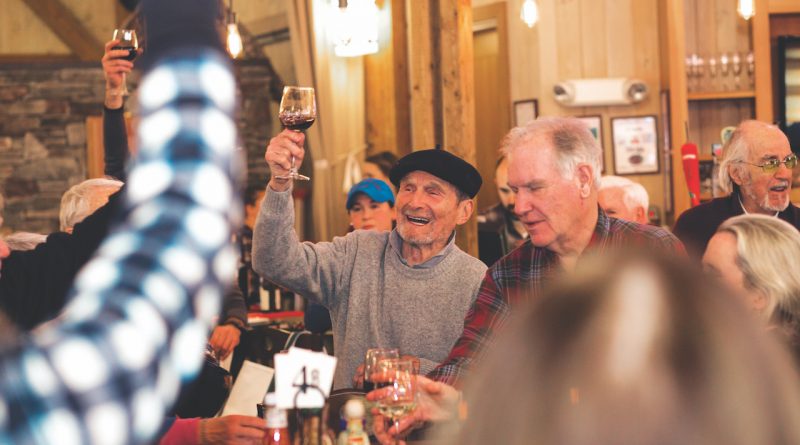
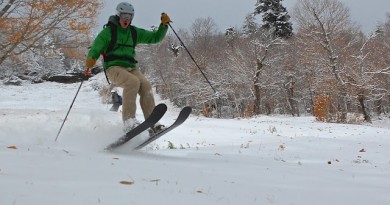
Pingback: Read The Winter Issue! — VT SKI + RIDE Magazine